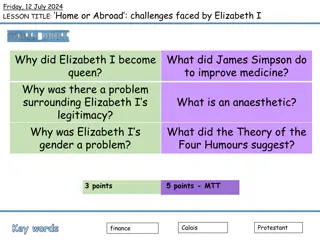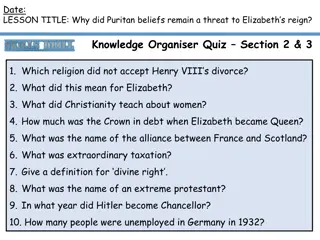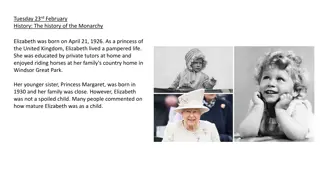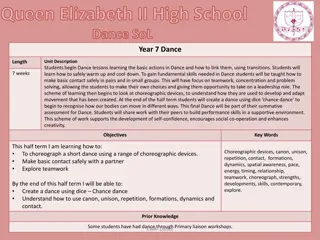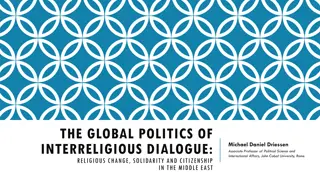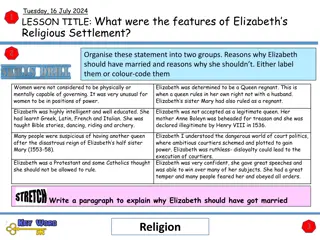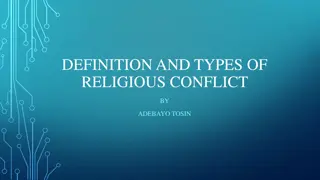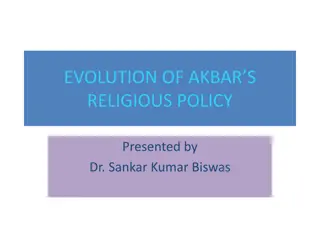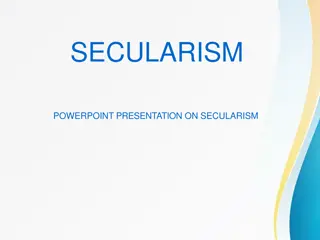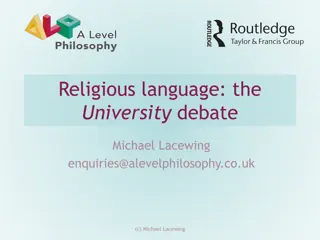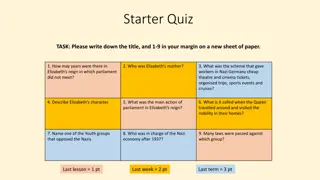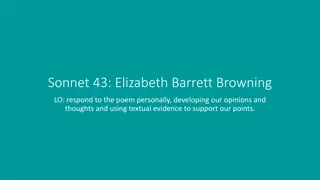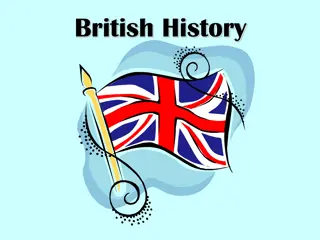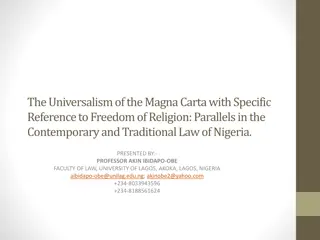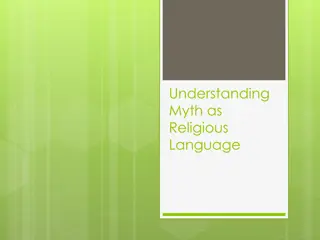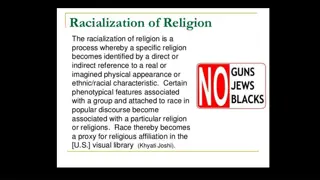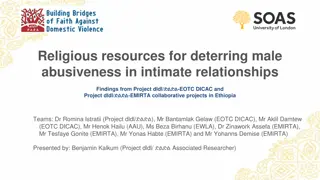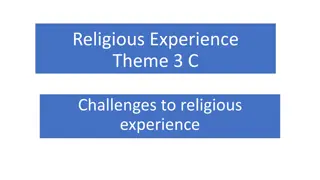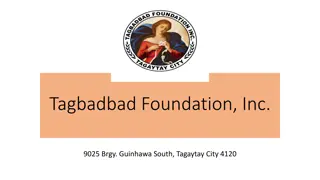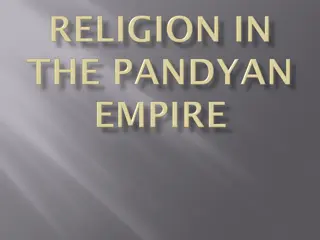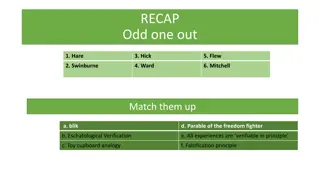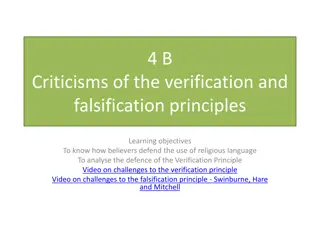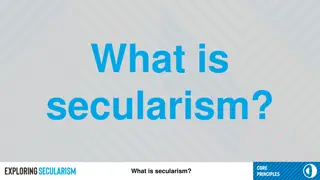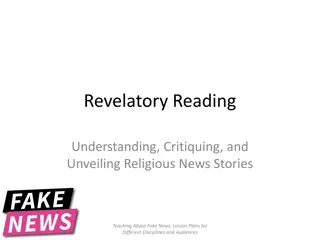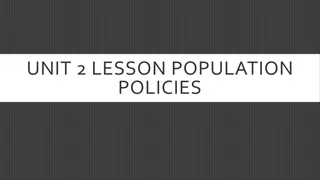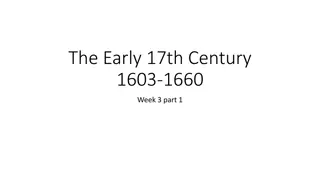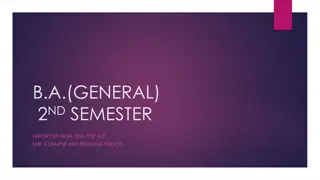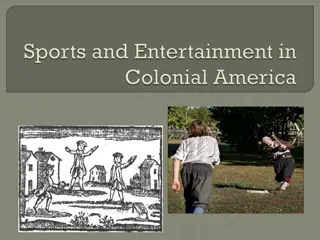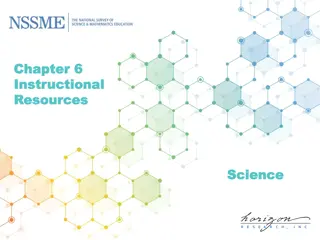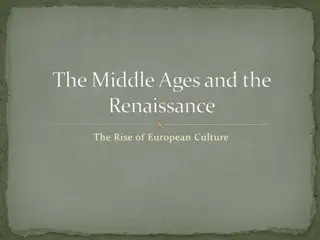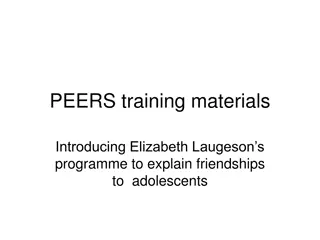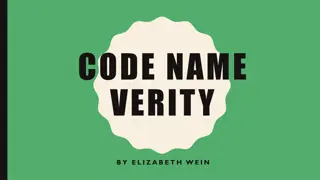Religious Policies of Queen Elizabeth I: Seeking a Middle Way
Queen Elizabeth I of England navigated religious turmoil by establishing a middle way that balanced Protestant and Catholic elements. Her reign saw the passing of acts like the Act of Supremacy and Act of Uniformity to consolidate her power and create a distinct Church of England. Despite facing opposition from Catholics, Elizabeth's religious policies aimed to prevent civil unrest and solidify her authority.
Download Presentation

Please find below an Image/Link to download the presentation.
The content on the website is provided AS IS for your information and personal use only. It may not be sold, licensed, or shared on other websites without obtaining consent from the author. Download presentation by click this link. If you encounter any issues during the download, it is possible that the publisher has removed the file from their server.
E N D
Presentation Transcript
GCSE HISTORY Elizabeth I Trouble at home and abroad British Depth Study
Why did Elizabeth try to find a middle way? Religion introduction Elizabeth s father had broken from Rome, and the English reformation had created religious confusion and tension. Henry VIII s successor, Edward, had been a strict Protestant while his successor, Mary, was a devout Catholic. Trying to avoid these extremes, Elizabeth instead sought to establish a Middle Way in religion. Elizabeth s religion Elizabeth was a Protestant. She was Anne Boleyn s daughter born after the break with Rome. When she became Queen she forbid priests from performing traditional mass in royal chapels, rejecting the old Catholic idea of transubstantiation. Transubstantiation is the Catholic belief that the bread and wine at mass becomes the body and blood of Jesus Christ. Elizabeth also hated prayer books being covered in pictures of saints, as Protestants like Elizabeth hated the use of superstitious images. However, Elizabeth was no religious radical she liked certain elements of the Catholic Church, particularly church decorations and church music. Elizabeth s religious aims Elizabeth s aims were more political than religious England was very divided - she wanted to heal divisions between Catholics and Protestants before they led to civil war Protestants were strong in the South East of England, but Catholics remained strong in the North and the West. Elizabeth wanted to maximise her personal power and wealth by taking as much control over the church as she could. This did not please the Pope in Rome.
The Act of Supremacy, 1559 In May 1559, The Act of Supremacy was passed. The Act; Re-established the break from Rome and an independent Church of England. All members of the Clergy swore an oath of loyalty to Elizabeth The Church would keep its existing, pre-reformation episcopal structure two archbishops (at Canterbury and York) and various bishops below them helping Elizabeth to govern the Church. This was to keep Catholics happy as the European Protestant churches had got rid of this hierarchy. Elizabeth chose the less controversial title of Supreme Governor of the Church of England rather than Supreme Head. She hoped this would pacify the Catholics who still regarded the Pope as the Head of the Church. The Act of Uniformity, 1559 In May 1559, a second Act - The Act of Uniformity was passed. The Acts aim was to make it very clear what the Church of England believed in hoping to end quarrels between Catholics and Protestants. The Act; Included 57 rules to be followed A new Book of Common Prayer was issued Traditional Catholic Mass was abandoned The Bible was written in English Services were held in English The Clergy were allowed to marry Old Catholic practices such as pilgrimages and saints imaged were banned However, some effort was made to pacify English Catholics. Catholic ornaments such as crosses and candles could be placed on the communion table Priests wore traditional Catholic style vestments rather than the plain black ones worn by Protestants
The Catholic Threat in Elizabethan England There were still plenty of Catholics in England. They were unwilling to accept Elizabeth as Head of the Church of England, which meant that they were not allowed to accept public office (e.g. MPs, judges). Attendance at Anglican (Protestant) churches was made compulsory. Catholic opposition came in three main forms: The Pope The Pope was Head of the Catholic Church. He ordered Catholics in England not to attend the Anglican services. The Pope became more of a threat in 1570 when he excommunicated Elizabeth. Excommunication means you are excluded from the Christian Church. This increased the Catholic threat, as it said that Catholics no longer had to be loyal to the Queen and directly ordered them to disobey her laws or be excommunicated themselves. This encouraged Catholic plots and assassination attempts. It meant that Elizabeth was called a heretic, and was sentenced to go to hell. The document which said she was excommunicated was called the Papal Bull Response Treason Act 1571 Denying Elizabeth s supremacy or bringing the Papal Bull into England was punishable by death. Anyone who left the country for six months had their land confiscated to prevent English Catholics leaving to train as missionaries. Recusants A recusant was someone who refused to attend the Anglican Church. They did this because they were following the Pope s instructions. It was not acceptable to Elizabeth that they listened to the Pope instead of her. Response Recusants were initially fined one shilling per week for not attending Church. If you attended Mass (Catholic Service) instead, you were fined. The priest performing Mass could be executed. By 1581, following various plots, the fine for recusancy rose to 20. This was far less affordable.
Jesuits and Seminary Priests These were both types of missionaries Priests who would go out to covert people to Catholicism. Seminary priests were trained in the Netherlands, to train up missionaries to keep Catholicism alive in England. Jesuits Jesuits emerged as a threat in the 1580s. They were dedicated to the Pope. They had rigorous training and were sent to England as educators. Their plan was to target nobles, especially in the North West where Catholicism was strong. Once in England, Jesuits would help to smuggle other priests into the country. The most famous example was Edmund Campion. He was a brave, charismatic leader and went to Lancashire, where Catholicism was strongest. He held Church services in the homes of important Catholic families. This had to be done in secret so Campion would wear disguises and use safe houses to avoid arrest. Priests would hide in priest holes cleverly concealed rooms and spaces where priests could hide, and illegal Mass could be held. Nicholas Owen was one carpenter who was key to making secret safe houses. One priest hole in a house in Warwickshire could only be reached by climbing down the hole of a 15th century toilet. Response to the Jesuits The problem with Jesuits was they were hidden. Sir Francis Walsingham sent out pursuivants, who would raid houses and even rip them apart, looking for priest holes. This meant that Edmund Campion was found within a year of his arrival. Walsingham s spy network found him, he was sent to the Tower of London and tortured on the rack. He was offered his freedom if he converted to Protestantism, but he refused. In 1593, large gatherings of Catholics was illegal. Catholics were no longer allowed to travel more than 5 miles from their home. Was Elizabeth successful at dealing with the Catholic threat? Overall Elizabeth was successful. By 1603, only 10% of the population were sympathetic to Catholics. Only 2% were actual recusants, who refused to attend Anglican Church. However, it was not all down to Elizabeth. The Pope and Spain s involvement in treasonous plots to overthrow Elizabeth was too much for some English Catholics. This made Catholicism seem foreign and unpatriotic.
How did Elizabeth deal with the Puritan threat? It was not only Catholics who were unhappy with Elizabeth s religious settlement. Puritans were also unhappy with the compromise. For them the old Roman Catholic Church was corrupt and too many of its traditions were based on superstition, not the Bible. They found the Catholic parts of Elizabeth s middle way offensive. In particular, they were angry about the continued existence of bishops and about the vestments worn by the clergy. Like the Catholics, they became a particular problem from the 1570s onwards. There were many senior people at Court, in the Church and in Parliament who were sympathetic to the Puritans. Even Elizabeth s favourite, Robert Dudley was a Puritan. The Puritans became a real threat when some started to call for the abolition of bishops. Elizabeth was horrified at the suggestion that the Church hierarchy should be removed, seeing the idea as being dangerous and revolutionary to her own authority. Puritan printing presses were destroyed in 1572 after two pamphlets criticising the structure and beliefs of the Church were published. Puritan ideas were, however, debated in Parliament at this time. This angered the Queen, who rejected any bills proposed by Puritans. Eventually in 1576, she stated that MPs were no longer allowed to discuss religious matters without her permission. When the Puritan Peter Wentworth challenged this, he was imprisoned. The Puritan threat also led to a serious disagreement between the Queen and the Archbishop of Canterbury, Edmund Grindal. She was concerned about the practice of prophesying. These were prayer meetings where the Bible was discussed and debated and where sermons were said. Essentially, they were training sessions for the clergy. However, Elizabeth was concerned that such meetings were a dangerous opportunity for spreading Puritan ideas around the country. When Grindal refused to close them down, Elizabeth had him placed under house arrest, where he remained until his death.
Grindals eventual replacement was John Whitgift. He ended prophesying. He also immediately issues the Three Articles, forcing all members of the clergy to swear absolute acceptance of bishops. The fact that 300 ministers were suspended as a result of this points to the mixture of opinions which existed within the Elizabethan church. In the same year as Whitgift s appointment, a Puritan called William Stubbs had his hand cut off for writing a pamphlet criticising Elizabeth. Archbishop Whitgift s harsh approach pushed a few Puritans into breaking away from the protestant church altogether to become Separatists or Brownists,named after Robert Browne who was arrested after setting up a separate congregation at Norwich. Later, Puritan pamphlets appeared their inappropriate language and disrespectful tone shocked many people and turned them people against the Puritans. In 1593, the government passed the Act Against Seditious Sectaries, which allowed the authorities to execute anybody suspected of being a Separatist. John Whitgift Conclusion on Catholic and Puritan threat. Elizabeth s settlement (middle way) was very intelligent as it satisfied most people. Her Anglican Church was a Protestant Church that looked Catholic. This cleverly recognised that most English people would be willing to accept some Protestant beliefs if the Church kept its traditional appearance. Elizabeth believed that the Middle Way was the only way of brining political stability and religious harmony to England. However, not everyone was happy. Both Catholics and Puritans tried to overthrow it at certain points but the religious settlement of 1559 remained in place. Elizabeth became increasingly intolerant of religious differences after the 1570s (after she was excommunicated). The government measures applied pressure on those who would not accept the Middle Way. Most Puritans remained Anglicans, and few Catholics were bold enough to be recusants. Extremists were dealt with firmly. Government propaganda was used effectively to destroy the reputation against both Catholics and Puritans. By 1603, Elizabeth had succeeded in winning over the majority of the population.
Who was Mary, Queen of Scots? Profile Born in December 1542 daughter of James V of Scots and Marie De Guise Became Queen of Scotland aged 6, but lived in France between 1548 and 1561. Her mother ruled Scotland as regent in her absence. Mary returned to Scotland in 1561 Scotland was going through its own protestant reformation. This put Mary at odds with her own people Mary was very much a foreigner in her own land. Brought up as a Roman Catholic. Considered beautiful and intelligent, Mary was musical and a accomplished linguist Mary married the heir to the French throne but it was only brief as he died Mary s second marriage to Henry, Lord Darnley, was brief and unhappy, but produced a son called James. Darnley was murdered and Mary s third marriage to Earl Bothwell triggered a chain of events that led to Mary s forced abdication in 1567. She was succeeded by her baby son, James VI. Mary fled to England and lived in captivity, though in relative luxury, for nineteen years.
Mary a rival to Elizabeths throne! England had always had a difficult relationship with Scotland, but the situation was further complicated because of Elizabeth s refusal to marry. As Elizabeth had no children, Mary was a potential heir to the English throne. Mary was a descendant of Henry VIII s oldest sister who was married to the Scottish Royal family (Stuarts) Mary was keen to assert her claim and therefore Elizabeth was deeply suspicious of her cousin. Elizabeth had suggested that Mary marry her own favourite, Robert Dudley, as a way of controlling the Scottish Queen. Mary instead married her own cousin Lord Darnley. Like Mary and Elizabeth, Darnley was also descended from King Henry VII, and this marriage strengthened Mary s claims to the English throne. Elizabeth was furious! Mary s marriage to the violent and drunken Darnley was not a success. When he was murdered, after less than two years there was gossip Mary had arranged the crime. The rumours were strengthened further when she promptly took a third husband, Earl Bothwell. Bothwell was widely suspected of having arranged Darnley s murder. Civil war broke out in Scotland. Mary was forced to abdicate in favour of her infant son. (James VI) Mary comes to England Mary quickly escaped captivity and fled to England, arriving, disguised in a fishing boat in May 1568. Mary might have been Elizabeth s cousin, but her arrival on English soil was unwelcome news to Elizabeth. Mary was pro-French, a Catholic and a potential heir. Those who questioned Elizabeth s legitimacy even considered Mary to be the rightful Queen of England. Elizabeth certainly did not want such a threat at her Court. Elizabeth was afraid Mary could act as a focus for Catholic resistance. Elizabeth chose to keep Mary under house arrest far away in the North, in isolated locations far from the coast and from London. In this way, she hoped to limit any threat that Mary might pose.
Plot # 1 The Northern Rebellion 1569 Mary s arrival in England triggered a Catholic rebellion. This plot started as a Court Conspiracy. The Duke of Norfolk played a central role .He was the most senior English noble and the wealthiest landowner in the country and a cousin of the Queen. Norfolk did not like that William Cecil had so much power as Elizabeth s chief advisor, and he felt that the work he did went unnoticed. Norfolk was also a secret Catholic. Norfolk planned to marry Mary and set her up as Elizabeth s heir to the throne of England. At this stage he did not have a plan to remove Elizabeth from the throne. Norfolk had help from two of Elizabeth s Courtiers. Robert Dudley was one of those courtiers. He was interested in the plot to reduce Cecil s power, but did not want to plot against Elizabeth and confessed everything to her. Norfolk fled Court, was captured and begged for Elizabeth s forgiveness. The Plan Although Norfolk had ordered there not to be a rebellion, there were rumours that an uprising was planned. Elizabeth brought the Earl of Northumberland and the Earl of Westmorland to Court. She was suspicious that they were both Catholics who were disloyal to her. However Elizabeth s plan backfired and the two Earls joined forces to lead a rebellion against her. They used Church bells to call out to people to rebel. Over 5000 people joined together to rebel against the Queen. These were mostly people who had remained Catholic and were not happy with Elizabeth s religious changes. They wanted Mary Queen of Scots to be on the throne. There is no direct evidence that Mary agreed with this plot or had any influence over it. On 14th November 1569, the rebels headed down south after hearing mass at Durham Cathedral. The rebels expected to have help from the Spanish. Elizabeth s government were very worried about this rebellion. The Rebellion
However the Spanish did not turn up to help. They did not like Mary Queen of Scots as the Spanish did not have a good relationship with the French. The Earls and their rebels had not properly mobilised their forces and the rebels were not organised. As the Queen s army moved north, rebels started to retreat. How did it go wrong? After the rebellion Elizabeth wanted strict control. She executed 450 rebels and confiscated land off nobles who had been part of the rebellion. She also reorganised the Council of the North which gave her more control. Westmoreland escaped but Northumberland was betrayed and beheaded. The Privy Council wanted Norfolk to be executed as well but the Queen locked him in the tower of London, possibly out of family loyalty as he was her cousin. It was seen as a Catholic rebellion and therefore from Elizabeth s point of view she needed to have stricter control over the Catholics. The rebellion arguably strengthened Elizabeth s position as such a huge rebellion was stopped by her army. How did the rebellion affect England?
Plot # 2 The Ridolfi Plot 1571 Roberto di Ridolfi was a Catholic Italian banker who lived in London. This plot was an attempt to restore Catholicism in England. It involved Mary Queen of Scots, the Pope, Philip II of Spain and the Duke of Norfolk. This time, the plan was far more dangerous. Elizabeth had been excommunicated by the Pope in 1570 so the Catholics were encouraged to rebel against her as they were told not to see her as a religious leader. The plan was to assassinate Elizabeth and for Mary Queen of Scots to be put on the throne. The idea was that 6000 Spanish troops would arrive to help. Ridolfi optimistically thought that over half of the nobles were Catholic and would support him with this rebellion. The plan was that after Elizabeth was killed, Mary would marry the Duke of Norfolk and they would rule together. Mary is said to have agreed with this plot as she was losing hope of Elizabeth releasing her from house arrest. The Plan Elizabeth s intelligence network soon discovered the plot. Ridolfi was abroad when the plot was discovered so he escaped arrest. How Did it Go Wrong? Norfolk was arrested and found guilty of treason. Elizabeth was reluctant to sign his death warrant as he was her cousin and England s only Duke. But she eventually did and he was beheaded at the Tower of London in 1572. Parliament passed a law directed against Mary, that declared anyone making a claim to the throne, or anyone knowing of a plan to assassinate the monarch should be removed from succession. (They would not be allowed to be an heir to the English throne). Elizabeth absolutely refused to execute Mary and she remained locked up. She was her cousin and also had come to England for protection. How did the Plot Affect England?
Plot #3 The Throckmorton Plot 1583 In 1583 the plan was made for a Catholic French force, backed by the Spanish and Papal money to invade England. Mary was to be freed from house arrest and the uprising would involve the Jesuits, Seminary Priests and English Catholic Population. Elizabeth would be captured and killed. Mary would then become Queen. The plan would be led by Francis Throckmorton and the Spanish Ambassador. How Did it Go Wrong? Walsingham (Elizabeth's chief spy) found out about the plot before plans could be put in place. Throckmorton was watched for six months and then arrested for treason, tortured on the rack and admitted to a plot. He was then executed for treason. How Did the Plot Affect England? Following the plot, the Bond of Association was established. This meant anybody associated with an assassination plot against Elizabeth would not be able to benefit from the Queen s death in any way. The Plan The Spanish Ambassador was sent back to Spain and there were to be no more ambassadors from Spain during Elizabeth s rule. There was a lack of evidence against Mary having any involvement so she was not tried or executed.
Plot #4 The Babington Plot 1586 Inside her house arrest by 1586, Mary was not allowed any visitors and all of her letters were read. Her jailor was a strict Puritan who Elizabeth picked so he would be anti-Catholic. Mary was growing very resentful and depressed at having being locked up for nearly twenty years. The Plan Mary began a secret correspondence with Sir Anthony Babington. He was a Catholic recusant. Letters between Babington and his Catholic co-plotters and Mary were sent back and forth in code. By mid-1586 a plan to free Mary had been devised. They would kill Elizabeth and put Mary on the throne with the help of a Spanish invasion force. How Did it Go Wrong? Walsingham knew all about the letters and had been monitoring the situation. He placed an agent inside Mary s castle and intercepted the letters. He allowed it to continue as he wanted to trap Mary and have hard evidence against her, which he had not managed to gain from any of the other plots so far. On 17th July 1586 Mary wrote a coded letter agreeing to the plot. Babington and his men were arrested and hung, drawn and quartered. The Privy Council finally had proof against Mary Queen of Scots plotting to overthrow Elizabeth and Parliament pushed for her to be executed. Elizabeth was not sure at first as Mary was her cousin and she refused to sign the death warrant. Elizabeth only signed eventually when there were rumours of the Spanish helping Mary escape. Historians have debated whether Elizabeth genuinely did not want to kill her cousin or if she just wanted to appear that way. Elizabeth gave specific instructions that although she had signed the warrant, it was as a precaution and not to take any action. Her advisors ignored this and executed Mary anyway. When Elizabeth heard this she was extremely angry. Elizabeth had been worried about a Catholic revolt after Mary s death, but there was not one which showed that most people in the country were loyal to her, and many did not like the thought of a plot to kill the Queen; Catholic, Protestant or not. How Did this Affect England?
What were the causes of the Spanish Armada? There are many causes as to why the Spanish Armada set sail. These can be placed into four main causes; Privateers, Economy, Religion and Marriage (PERM). Privateers Sir Francis Drake and other English sailors had spent years raiding Spanish ports and ships. The Spanish also attacked English trade ships. The key example is in 1568, when the Spanish attacked John Hawkins and Francis Drake at San Juan in the Caribbean where they had been trading, as the Spanish saw it, illegally. The fact that Spain wouldn t let England trade in the New World was another cause of tension. Economy England s support of Protestant Netherlands was a significant cause of tension between England and Spain. There was an important economic connection to the Netherlands for England as the two countries were linked by the cloth trade. This was important for: Wool producers amongst the gentry (who had swapped to sheep farming with enclosure) London merchants Elizabeth - she gained vital customs revenues, paid when you export cloth. Philip II realised the importance of this trade and banned English traders from Antwerp the main port for the cloth trade twice during the 1560s to put pressure on Elizabeth.
Religion Uneasy peace existed between the two nations. Philip was Catholic and wanted to restore Catholicism in England. He hated Elizabeth s Middle Way. In 1570, the Pope excommunicated Elizabeth and called for all Catholics to challenge her rule. As a Catholic, Philip was keen to follow the Pope s instructions. Philip also ruled the Spanish Netherlands and in 1567 he sent an army there to crush a Protestant rebellion. The Spanish believed that England was supporting the rebellion in the Netherlands. The Spanish thought that if Elizabeth was overthrown, this would help solve their problem in the Netherlands Mary the Queen of Scots (Catholic) being executed by Elizabeth was the last straw for Philip. Marriage Philip II of Spain had been married to Elizabeth s sister, Mary I. During this time, he had been joint monarch of England. The plan was that their child would unite England and Spain under one Catholic King or Queen. When Mary died childless, the plan died. Philip II proposed to Elizabeth in 1559, but she kept him waiting. When it was clear there would be no marriage, tensions grew. PERM
The event 28 May 1588 The Armada left Lisbon. However the fleet ran into storms and had to return back for repairs. They set sail again, this time successfully entering the English Channel in an unbreakable crescent formation. 19th June 1588 The Armada make a month-long stop at Corunna to resupply. It sets sail again on 21 July. The Armada is sighted from Lizard Point, Cornwall. A system of beacons across the South Coast were lit to send a warning to London. 31 July 1588 As the Spanish sailed up the Channel, they were followed by the English fleet. The two fleets briefly fight, with the Armada successfully maintaining its crescent formation. Spain lost 3 ships, England 0. 2nd - 6th August 1588 The Armada moves up the channel towards Calais, followed all the way by the English fleet. This made it impossible for the Spanish to retreat. The Armada anchored at Calais waiting for Parma s troops. However communication between Medina Sidonia and Parma in the Netherlands was impossible.
7th August 1588 On this night, the English sent eight unmanned fire ships into the anchored Spanish fleet. This caused panic, collisions and they cut their anchor ropes. The English had succeeded in breaking the tight crescent formation. 8th August 1588 The next day, the two fleets fought at the Battle of Gravelines. The English had an advantage after breaking the crescent formation. They destroyed five Spanish ships. No English ships were damaged. 1000 Spaniards were killed. Elizabeth gives her stomach of a king speech to the troops at Tilbury in case a land battle occurred. 9th August 1588 The Spanish Armada are forced to retreat North due to the wind. This meant that they could no longer pick up Parma s army and Medina Sidonia knew the Spanish were beaten. The only route back to Spain was 2,000 mile route around the North of Scotland. August-September 1588 The Armada were chased by the English as far as the Scottish border. The Spanish were battered by storms around the coast of Scotland and Ireland. Only half their ships returned to Spain and 20,000 Spaniards killed.
LEADERSHIP Monarch: King Philip II Many historians lay the blame of the Spanish Armada on Philip. There were two options for Spain - send a fleet, or get an army from the Netherlands into England as a surprise attack. Philip tried to attempt both at the same time. The enormous fleet would sail to the Netherlands, move Parma s army across, and conquer England. It was too complicated to unite the two forces. Monarch: Queen Elizabeth Seen as a weak and feeble woman , the Spanish Armada was not an event which played to her strengths, as military matters were seen to be a job for Kings, not Queens. She gave an impassioned speech at Tilbury, motivating her soldiers but this had no practical impact as there was never a land battle, and the Armada was already retreating by then. However, Elizabeth chose her commanders well. Admiral: Medina Sidonia In May 1588, the Spanish Admiral Santa Cruz died. He was replaced by the Duke of Medina Sidonia, one of the wealthiest noblemen in Spain. He told Philip that he did not want the job, he lacked self confidence and no experience of fighting at sea. He showed little initiative. Admiral: Lord Howard Elizabeth, like Philip, chose a leading nobleman to control her argumentative sailors Vice-Admiral: Sir Francis Drake Francis El Draque Drake terrified his colleagues as much as the Spanish. He was fobbed off with the position of Vice- admiral. Lord Howard was a safer pair of hands. Drake s tactical ingenuity contributed directly to the English victory, with the Raid on Cadiz and the fireships. Army: An expert military leader and Philip II s nephew, Parma amassed the 30,000 strong army in the Netherlands, but had no way to co-ordinate with Medina Sidonia to move them. Duke of Parma Commander: John Hawkins Designed the new manoeuvrable English ships which beat the Armada
FLEET & TACTICS . Fleet Philip prepared a huge fleet of 130 ships armed with 2500 guns. These were a professional army. He had 30,000 men waiting to be picked up at the Netherlands. However the waters were too shall for the Spanish galleons to enter, so they were unable to pick up their extra troops. Fleet Elizabeth had an army of 20,000 but they had little training or equipment. She also spread her men across the coast as she did not know where the Spanish would land. There were only 34 battleships in the English Navy, however private individuals ordered ships which meant 200 ships were ready for war. The English Fleet was led by Elizabeth s cousin, Lord Howard, who was assisted by second in Command, Sir Francis Drake. He was very experienced. Tactics They had a defensive formation of a crescent which protected the supply ships. However the warships were hard to steer and their guns were difficult to load which made firing slow. Their usual tactic relied on getting close to the enemy and using short- range guns. They would hook on to the enemy ships, so they could board them and take them over. Philip appointed Duke of Medina Sidonia to lead the army. He had no experience at sea and suffered from sea-sickness. Phillips key plan of close communication between Sidonia and the Netherlands commander was impossible. Tactics A system of beacons had been built around the south coast of England to send news of the Armadas arrival to London and church bells were also rung out. The English ships were designed so they were lighter, faster and more manoeuvrable than the Spanish ships. The English also kept their distance from the Spanish using long range guns called Culverins. The English set oil ships on fire and drifted them towards the Spanish fleet. This panicked the Spanish fleet and broke the tight crescent formation of the Spanish. Elizabeth also visited her troops on land and gave them an inspiring speech.
The consequences of the Spanish Armada defeat Positive Negative There were great celebrations in England. Spain were humiliated by their defeat. The Armada caused England to go into debt, which made inflation and the poverty crisis worse. The victory had an enormous propaganda value for Elizabeth e.g. The Armada Portrait. The Anglo-Spanish War dragged on long term. The English launched an unsuccessful counter-Armada against Spain in 1589 and Philip launched two failed Armadas in 1596 and 97. National pride was boosted. The important role played by the Protestant wind in England s victory was taken as a sign of God s approval of Protestantism. Philip aided a Catholic rebellion in Ireland. England established as a major naval power.



